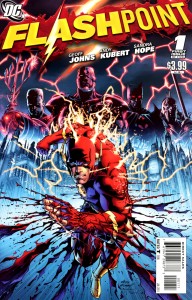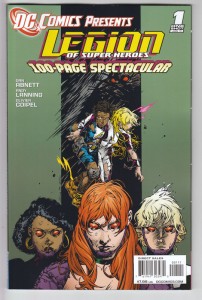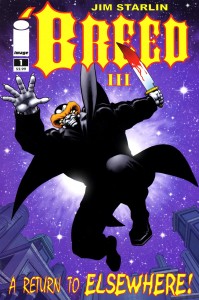Yes, time once more for CoaCSJ, in which I take a paragraph or three and review recent comics and graphic novel releases, most of which should be on sale at a comics shop or online merchant near you.
 FLASHPOINT #1
FLASHPOINT #1
Script: Geoff Johns; Art: Andy Kubert, Sandra Hope
DC Comics; $3.99
Well, here we go again with another universe-changing mega crossover series! I suppose the Big Two are convinced it’s the only way to drum up interest in their offerings, so we may as well stop bitching about them. This one uses the whole Flash mythos as its springboard, unsurprising since it is Geoff Johns at the helm, after all. We join Barry Allen who wakes up literally in another reality, a “Mirror, Mirror” or It’s A Wonderful Life –style scenario in which he has no powers and none of his chums in the superhero community know who he is, either. One upside: his mom is alive. One of many downsides: his wife Iris doesn’t know him. Also: Wonder Woman and Aquaman are battling each other over the right to conquer the world, and we’re appraised of this by Cyborg of the Titans, who’s assembled a group of reimagined versions of such various characters as Flash Rogue Captain (here”Citizen”) Cold, Element Woman (depicted as a lot like the loopy Delirium of Sandman fame), the Marvels, and the Enchantress (curiously, not that different from her 80’s incarnation, also sporting that kicky witch’s hat I like) to try to persuade Batman, who’s even more ruthless and a bit seedy to boot, to help them battle this threat. Barry also goes looking for Batman at the Batcave at Wayne Manor, and gets a bit of a surprise. End of chapter one!
To be honest, this seems like it would make a very good Flash story arc, but as it is, it seems like an awfully flimsy basket to hold all the eggs that DC wants it to. Johns knows Flash lore inside and out, and he seems to be having a good time coming up with ways to tweak it a little. I wish this sense of fun extended to the narrative, but everything here is as drearily dour and earnest as DC and Marvel feel like superhero comics have to be these days to be taken seriously. I don’t agree with that, but obviously I’m in the minority. Andy Kubert does a solid, professional job; he’s a very good artist, as is his brother, drawing dynamically composed panels and figures…but there’s just something about their styles, that Kubert School way of drawing people, for lack of a better way to describe it, that keeps me at arm’s length. Who knows, it’s early and there’s a lot of paper to go, spread across a number of titles, and it may get all wiggy and interesting before it’s over. I wouldn’t bet the farm on it, but I suppose hope springs eternal. Anyway, if you’re all about these big multi-issue epics, here’s your jumping-on point, and between this and the whole Fear Itself thing your big multi-issue epic jones is taken care of for 2011 and its immediate future.
 DC COMICS PRESENTS: LEGION OF SUPER-HEROES: LEGION OF THE DAMNED
DC COMICS PRESENTS: LEGION OF SUPER-HEROES: LEGION OF THE DAMNED
Script: Dan Abnett, Andy Lanning; Art: Olivier Coipel
DC Comics, $7.99
The Legion of the 90’s was a curious thing. Oh, it wasn’t all that different from what had gone before and what has come since, but if ever there were series that came across as guilty pleasure viewing, like your favorite daytime soap opera (itself now a dying breed), the 90’s overlapping Legion of Super-Heroes and Legionnaires was/were it, and I was definitely bitten by that bug. Of course, I had read Legion comics before; I liked the short-lived 70’s Cary Bates/Dave Cockrum era quite a bit, and was fond of the early 90’s Tom and Mary Bierbaum/Chris Sprouse/Karl Story/later Adam Hughes iteration as well. This particular version was born out of the ashes of that one, reimagined (as so many series were at the time) via Zero Hour, DC’s do-over for, theoretically, things that had been messed up in Crisis on Infinite Earths as well as the chance to launch a gaggle of “legacy characters”, i.e. old names, new faces. Sometimes it worked, sometimes it didn’t; Starman was a aesthetic success, the grim and gritty Hawkman not so much…and I’d put the Legion reboot, headed by Mark Waid and Tom Peyer and later Roger Stern and Tom McCraw, in the qualified success column as well.
Retaining most of the old members, some with radically rethought origin stories in the process, characterization was the emphasis and big events not so much- most major storylines wrapped in no more than three issues, though some plot threads continued on; one major exception being the Legion in the 20th Century storyline which ran through both titles simultaneously (they came out in concurrent months, and were numbered consecutively, independent of the issue number, on the cover) and seemed to go on forever, with half the team encountering modern-day friends and foes, and the other remaining in the 30th Century. There was always a sort of light touch overall, regardless of the writer; though there was drama, generally things tended to work out to the benefit of our team in the long run. It really sort of ran against the grain of most mainstream superhero comics of the 90’s, which seemed to go out of their way to amp up the doom and gloom and blood and general urgh feeling. This was especially reinforced by the art, specifically the Legionnaires team of Jeffrey Moy and W.C. Carani, whose style, while pleasing to the eye, made the characters resemble the Campbell Soup Kids or Archie characters, one reason why this particular iteration was referred to as “The Archie Legion”. It was addictive reading for a while as the soap/space opera plotlines unfolded, but soon other, lesser artists took over and the stories got sillier and sillier and I bailed, thinking it would soon be cancelled and probably rebooted again. I was half right.
Having nothing to lose, apparently, the DC Powers that Be turned stewardship of the LSH to Abnett and Lanning, a pair of Brits who had been laboring, kinda under-the-radar style, on stuff like Marvel’s Force Works and DC’s Resurrection Man despite having an already-extensive background in British comics. As all good Brit writers worth their salt tended to do, especially then, they took a good, hard, objective look at the Legion and Legionnaires comics to date, and decided to strip out all the dead wood and rot, and present us with a more sober and serious 30th Century Earth, which had been taken over, literally possessed by an malevolent organic race called “The Blight”… and that included most of the Legion, as well! A handful of the members had been out in space on a mission, and returned to find the Earth “blighted”. They organized an underground resistance, and their struggle to save their friends as well as the rest of the world made up the six-issue story. By bumping up the stakes, and giving these stories real gravity and weight (speedster XS’s valiant, touching struggle to free Saturn Girl was one gripping example), Abnett and Lanning gave us a Legion story that mattered , as opposed to ones in which Brainiac was changed into a Bizarro or something like that. It was an exciting change. Another change was in the art- Olivier Coipel made his American comics debut with this arc as well, and it really polarized the LSH faithful. While many appreciated the dynamism he brought, as well as the energy in his layouts and figure drawings, many couldn’t get past his busy, fussy rendering style (he was referred to a LOT as “Ol’ Scratchy” on message boards and whatnot) and complained a lot. To me, his work was like a clean hit of oxygen after breathing industrial fumes for months; while Moy’s style was pleasant enough, the other Legion book had devolved into a tryout comic for marginal talents and it was great to see both series drawn by not only the same person, but one with a dynamic, fresh style. Of course, Coipel has gone on to much success drawing a number of series for Marvel in the years since, and has smoothed out a lot of his rough edges, not to his advantage, I might add- his art now, while still top-notch, misses the spark of his early work.
The story arc that succeeded this, scripted by Abnett and Lanning but not drawn my Coipel, set up their reunion via the Legion Lost limited series, which I thought was almost as good as Legion of the Damned. That set up a relaunched Legion title which started out strong but soon lost its way- Coipel bailed early to go to Marvel, and Abnett/Lanning seemed to lose interest though they went on to prove that hadn’t lost their cosmic knack via Guardians of the Galaxy and its sister books. But Damned will live on (though it’s been little-seen except by LSH readers of the time) as an example of a moribund, dying series that got a shot in the arm and became outstanding via a radically new creative team, and a theoretical template to follow for other publishers that may want to jumpstart other series. It was no mean feat, and it’s probably easier and cheaper just to cancel…but it can be done.
 ‘BREED III #1
‘BREED III #1
Script/Art: Jim Starlin
Image Comics, $2.99
There was a time in the mid-70’s when there was no creator that blew minds more thoroughly, not Kirby, not anyone, better than Jim Starlin. Introducing a crazy mix of pop psychology and New Age-style metaphysics into the standard Marvel superhero formula, he took two of Marvel’s most half-baked characters, Captain Mar-Vell and Adam (formerly “Him”) Warlock, and created two truly memorable series that still, more or less, hold up pretty well when one rereads them some thirty-plus years later. Starlin left Captain Marvel due to the time-honored “creative differences”, but settled them and moved on to Warlock, but that title was canned thanks to Marvel expanding too fast, then realizing they had to cut back on the number of titles they published. Still, Jim got to finish his Warlock saga in the pages of Avengers Annual and Marvel Two-in-One, going out on a high note…or at least as far as this sixteen-year-old was concerned. After that, Starlin went to DC to script Batman, and launched creator-owned series of his own, like Dreadstar and the first two iterations of this series, ‘Breed. He tried his hand at one of many Silver Surfer revivals back at Marvel. Sadly, while he was a better-than-average Batman scribe, and the other series had a following, to me none of it was as engaging as that early Marvel work. Eventually, he would even revisit Warlock and his cast, including Á¼bervillian Thanos and the soul gems, in a handful of Infinity this and Infinity that miniseries, with Starlin art acolyte Ron Lim, culminating in a relaunched Warlock series titled Warlock and the Infinity Watch in the 90’s…it, too, had its moments and ran a good long while but ultimately failed to match the initial excitement, as if Starlin was going through the motions, picking up a check, where before he had been gripped with mad inspiration.
So here we are in 2011, and Starlin is going back to the well with his ‘Breed. If you’re a hardcore Starlin fan, and I’m sure there are many out there, you’ll find much to like because it reads like every other Starlin work of this type, and uses the same bag of visual tricks that he always has employed, with one difference being the Photoshopped color- which he’s probably employed recently as well, it’s been a while since I’ve read much of anything with his byline. “‘Breed” refers to the race of demon/hybrid beings that counts one Ray Stoner among its number. He’s found himself defending a young lady (who he saw in a vision) and her son from these beings. He takes them back with him to his extradimensional home where fortunately for him, he loses the big ram’s-horn looking unibrow and looks like a normal person. After he gets them to safety in this place called “Elsewhere”, he proceeds to recap the events of (I assume) the previous two series, and it’s as long and ungainly infodump as I’ve ever read, I think. Long story short, our boy Stoner seeks to defend Earth from these demons, who are apparently preparing to invade and ravage it.
There was a time once, long ago, that Starlin had fresh (well fresh to mainstream comics, anyway) ideas and things he wanted to do with them. Religion, altered consciousness, the nature of reality vs. unreality, self-awareness, etc. were all grist for his mill, filtered through the prism of Kirby-style superheroics. Sadly, the Starlin of today, like so many of his peers (and many of the people who read him and write about him, I’d say), is now merely doing it for the money or because it’s expected of him. While this isn’t bad within its own narrowly-constructed frame, it’s all ideas and plots and even character designs in some cases that he’s been doing for years. If you’ve never read any of his other comics, you might find something of value here. Me, it just makes me kinda sad.
On a cheerier note, the All Purpose Review Writing Music List! Sly and the Family Stone- Small Talk; The Roches; Tim Buckley- Honeyman; Indigo Girls- Come On Now Social.
Coming soon, reviews of Peter Bagge and Gilbert Hernandez’ Yeah!, David Hahn’s All Nighter #1, Sonny Liew’s Malinky Robot collection, and Alan Moore and Kevin O’Neill’s League of Extraordinary Gentlemen: Century II: 1969. As always, thanks for your attention.





Comments